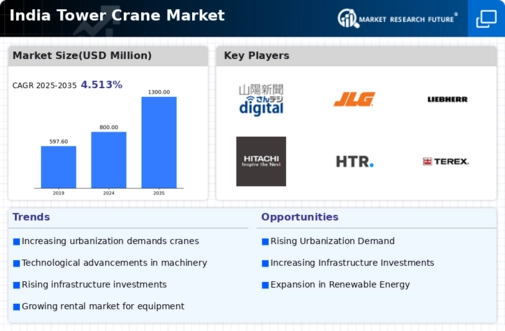Rising Demand for High-Rise Construction
The increasing preference for high-rise buildings in urban areas significantly impacts the tower crane market. As land becomes scarce, developers are opting for vertical construction to maximize space utilization. This trend is evident in metropolitan cities like Mumbai and Bengaluru, where the skyline is rapidly changing due to new high-rise projects. The tower crane market is poised to benefit from this shift, as these cranes are essential for lifting heavy materials to considerable heights. Furthermore, the market is expected to witness a growth rate of approximately 8% annually, driven by the ongoing construction of residential and commercial skyscrapers. This demand for high-rise construction not only enhances the market for tower cranes but also encourages innovation in crane technology to meet the specific needs of such projects.
Government Initiatives and Policy Support
Government initiatives aimed at boosting the construction sector play a crucial role in driving the tower crane market. Policies such as the National Infrastructure Pipeline (NIP) outline investments of over $1.4 trillion in infrastructure projects by 2025. This ambitious plan includes various sectors, including housing, transportation, and urban development, which are heavily reliant on tower cranes for efficient construction. The tower crane market stands to gain from these initiatives, as increased funding and streamlined regulations encourage construction companies to invest in advanced lifting equipment. Additionally, the Make in India campaign promotes local manufacturing of construction equipment, potentially reducing costs and enhancing the availability of tower cranes in the market.
Technological Innovations in Crane Design
Technological advancements in crane design and functionality are transforming the tower crane market. Innovations such as telematics, which allow for real-time monitoring and data analysis, enhance operational efficiency and safety. Additionally, the introduction of electric and hybrid cranes aligns with sustainability goals, appealing to environmentally conscious developers. The tower crane market is likely to see increased adoption of these advanced technologies, as they offer improved performance and reduced operational costs. Moreover, manufacturers are focusing on developing cranes with enhanced lifting capacities and reduced setup times, which could further stimulate market growth. As construction projects become more complex, the demand for technologically advanced tower cranes is expected to rise, indicating a shift towards smarter construction solutions.
Increased Investment in Real Estate Sector
The real estate sector in India is experiencing a resurgence, driven by factors such as low interest rates and increased consumer confidence. This revitalization is likely to bolster the tower crane market, as construction companies ramp up projects to meet the growing demand for residential and commercial spaces. According to recent reports, the real estate market is expected to reach $1 trillion by 2030, creating a substantial opportunity for the tower crane market. The influx of foreign direct investment (FDI) in real estate further supports this growth, as international players seek to capitalize on India's expanding urban landscape. Consequently, the demand for tower cranes is anticipated to rise, as developers require efficient lifting solutions to expedite construction timelines and enhance project delivery.
Urbanization and Infrastructure Development
The rapid urbanization in India is a primary driver for the tower crane market. As cities expand, the demand for high-rise buildings and infrastructure projects increases significantly. According to government data, urban areas are projected to house 600 million people by 2031, necessitating extensive construction activities. This surge in construction activities directly correlates with the need for efficient lifting solutions, such as tower cranes. The tower crane market is likely to benefit from this trend, as developers seek to optimize construction timelines and enhance safety. Furthermore, the government's push for infrastructure development, including smart cities and transportation networks, further fuels the demand for tower cranes, indicating a robust growth trajectory for the market in the coming years.






















Leave a Comment